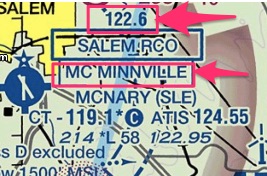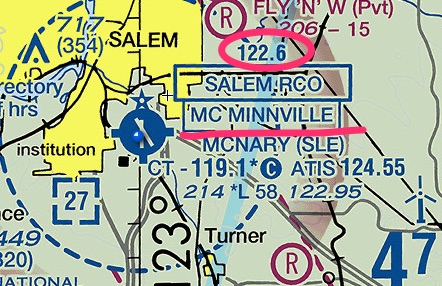Flight plans are an essential part of flight planning for both IFR and VFR pilots. Creating, opening and closing flight plans are relatively easy, if you know how to do it. But, as with anything, there are specific things you should know about how to close an IFR and VFR flight plan.
Before we get started on the intricacies of closing flight plans, check out these additional articles on flight plans:
How to cancel a VFR flight plan:
Unlike an IFR flight plan, you are not required to be on a flight plan for a VFR flight. I highly recommend you file and open a flight plan with FSS on every cross-country flight for search and rescue purposes.
Additionally, you can augment the search and rescue piece by using either a SPOT Tracker or Garmin InReach. The final safety measure is to pick up flight following.
When you do open your flight plan, though, you are required to close it or search and rescue activities will start.
How to cancel a VFR Flight Plan in the air:
This is a great option because once pilots land, they often can become overwhelmed with post-flight activities and forget.
Here’s the difficult part of closing a flight plan in the air: you can close it at any point during the flight, but you should be in close proximity to the airport.
The whole point of the flight plan is to activate search and rescue. It doesn’t make any sense to cancel a flight plan 30 NM from the airport. Who knows what will happen in that 30 miles?
The tricky part, however, is the airport terminal area is a dangerous place Your attention should be focused on traffic. Therefore 10NM out from the airport is a good place to close a flight plan if you chose to do it in the air.
Within 5 NM of the airport, your attention should be focused on other aircraft, but 10NM is close enough to still see the airport. 10NM out should give you enough time to contact the FSS and close the VFR flight plan.
But that begs the question, who do you call to close the flight plan?
How to find the Flight Service Station (FSS) frequency:
You can find the FSS frequency by looking at the VFR sectional. In the example below, you will find a solid box with the words “Salem RCO.” The “RCO” stands for “remote communications outlet.” This is what you are looking for, but you still need to dig deeper for one more piece of information.

Those words don’t mean much except to tell you it’s a communication outlet. As a pilot, you only need the word below: ‘McMinnville” and the frequency above: “122.6.”
The proper radio call is to “McMinnville Radio,” and not “Salem RCO.” It’s highly unlikely (although possible) the people monitoring the radio will answer to someone using “Salem RCO” as a heads up call.
Ideally, pilots should write this frequency down during pre-flight planning on their kneeboards for easy access. Do not make the mistake of trying to find this frequency and call sign in the air. That is poor cockpit management.
Now you know where to find the information let’s get into the next part.
How to make a radio call to the Flight Service Station:
Always start the radio transmission with a heads up call. They are busy and you’ll need to give them a second before you inundate them with your request.
Also, the initial call to the FSS should include their call sign and the frequency you’re on. They may be over 100 miles away and they monitor multiple frequencies through different routers.
Once they acknowledge you, then you can tell them where you are and what you want. Spell it phonetically.
The call would sound something like this:
“McMinnville Radio, Cessna 12345 on 122.6“
“Cessna 345, go ahead“
“Cessna 345, is 10 miles north of the Salem airport, Sierra, Lima, Echo, landing assured, please cancel my VFR flight plan.“
This process holds true whenever you need to call the FSS. Give a heads up call first and then always spell out your location or destination phonetically. The only difference to the call is the actual request.
The FSS can do a variety of tasks including file a flight plan if you forget or for IFR pilots who want to switch to a VFR flight plan and vice versa.
How to cancel a VFR flight plan on the ground:
This is super simple, just call 1-800-WX-BRIEF on the phone, give them your call sign and location, and they will cancel the VFR flight plan.
If you choose to cancel on the ground, make sure you remember to make the call. Many pilots walk away from the aircraft and forget.
This could result in the activation of search and rescue if they can’t reach you on the phone number you provided in your flight plan.
So, I recommend you add “cancel flight plan” to the end of your checklist if it isn’t there already.
Another technique is to put a post-it note on the car steering wheel before the flight so it’s there after the flight. Or better yet, never get out of the aircraft until you call FSS.
Whatever technique you choose, establish a habit so something will feel off if you miss the call.
If you are reluctant to put your cell phone number on a flight plan due to privacy concerns, I ask you to reconsider. Even the most diligent pilot will forget to close their flight plan at some point in their aviation career.
The cell phone number is the quickest way for ATC to reach you and to avoid any embarrassing erroneous search and rescue activities.
If you are on any type of social media or you use Google, you shouldn’t have a problem putting your cell phone number on a document only ATC uses and gets flushed from the system.
Will the airport tower close your VFR flight plan?
Yes, but ONLY if you ask them.
Tower will close an IFR flight plan automatically, but do not expect that level of service for VFR flight plans.
I have never personally asked tower or ground to close my flight plan. I like to keep the FSS and ATC separate. They serve different functions. In my experience tower controllers are reluctant to do anything with flight plans especially IFR flight plans.
But, maybe your local tower controllers are different. Give them a call on the phone and ask them. (just Google your airport and “phone number”) Or listen to what other pilots do with their flight plans.
Or better yet, just use Forflight, and don’t mess with any radio calls!
Can you cancel a VFR flight plan while flight following?
Yes, I believe so, but I wouldn’t do it. As with canceling with tower, I have never canceled a flight plan with ATC because the FSS and ATC provide different functions.
While I might ask a tower controller to cancel my VFR flight plan, I would never ask a controller during flight following to cancel my VFR flight plan
Note: canceling an IFR flight plan with ATC is a different story and I do that all the time on clear days. It’s expected and encouraged.
While a tower controller may have the time to push your request to the FSS, it is unlikely ATC providing radar coverage will have time. The ATC providing your flight following is also handling all IFR commercial traffic in your area. They are busy!
But again, next time you fly, just ask them. They might, or they might be so busy they tell you to contact the FSS. On a three am flight, though, you could probably convince them to give the FSS a call for you.
As a general rule, I wouldn’t establish a practice of using ATC to close VFR flight plans. The key to aviation is to establish a set of procedures, but since ATC may only help you 50% of the time, that’s too unreliable to create a sold, reliable habit.
How to cancel a VFR flight plan on Foreflight:
For those of us who use Foreflight, the closing and opening flight plans are exponentially easier than for those who don’t use it.
You simply click on “Flights,” find the flight plan you activated, and hit the “Close” button.
When you close or open your flight plan through Foreflight you do NOT need to call the FSS.
Foreflgiht will never open or close a flight plan for you. Pilots must take that action themselves.
Because Foreflight will never initiate that action for you, if you open it with the FSS station, you must close it with the FSS. However, if you open it with Foreflgiht, you can close it with the FSS. I have done that before and the controller can see you opened it with Foreflight (they told me over the radio they could see the origin).
Here is an image of the progression pilots will see on their screens as they progress through opening and closing a VFR flight plan.

How to cancel an IFR flight plan at an uncontrolled airport:
Most of the time you never have to worry about closing IFR flight plans; the tower does it automatically at controlled airports.
Things get more complicated when the tower is closed or the destination is an uncontrolled airport.
There are two ways to cancel an IFR flight plan at an uncontrolled airport: in the air or on the ground:
How to cancel an IFR flight plan in the air:
First, this is so important: pilots cannot cancel their IFR clearance unless they can maintain VFR cloud clearance.
So, when the field is IFR (1000′ and 3) do not cancel in the air. I would argue if the clouds are less than 3000′ and visibility is less than 5 miles, don’t cancel in the air either!
Why? It’s more important to focus on flying the approach. You can call approach when you land. Have you tried to pick up an airport visually when the visibility is less than 5 miles? It’s difficult at best.
Remember also that final approach fixes are typically built 5 miles out. If you can barely pick out an airport within 5 miles, your chances of a stable, safe approach diminish substantially. It gets real ugly real quick when you’re trying to locate the airport, cancel your IFR flight plan, set up for the approach, and stay clear of other traffic!
If the weather is good, though, this is a great option especially if radio reception is poor on the ground. Some airports out West have terrible communications on the ground. It’s best to call when you get the airport in sight at altitude.
Side note: When flying to an unfamiliar airport, if you don’t know what the reception is like on the ground, ask approach. They will tell you whether they can hear you transmit on the ground or if you should call on the phone to cancel.
Likewise, they will also tell you the altitude they can see you when you take off. This is important because you will have to stay VFR up to that altitude unless you open up your IFR flight plan on the ground.
Some pilots like to take off and pick up their clearance in the air which is fine unless the weather prohibits you from keeping VFR cloud clearance while ATC picks you up on radar.
It’s also a good practice to cancel in the air because it frees up other IFR traffic to land and depart. When pilots wait to cancel, no other IFR traffic can land OR takeoff until you cancel on the ground. This also includes Special VFR traffic.
However, don’t let other traffic pressure you to cancel prematurely because you want to be nice. When the weather is bad, the last thing you need is multiple aircraft trying to get into the same airport.
Do the approach safely then cancel on the ground. The other aircraft can hold.
When should you cancel an IFR flight plan in the air?
I like to cancel my IFR flight plan right after ATC clears me for the visual approach. In other words: I have the airport in sight.
When you cancel in the air you must include the words: “cancel my IFR flight plan.” The controller will come back and tell you to “switch to the advisory frequency and squawk VFR.”
You are now required to fly at a VFR altitude. (ie 6,500 feet or 10,500 feet)
You are also now responsible for your own aircraft separation even if you requested flight following.
If you want flight following, you must specifically ask for it. ATC will not have you switch to 1200. They will keep you on your current squawk code.
I have found flight following very helpful flying in the Willamette valley. A lot of aircraft fly around at 1500 ft MSL and when I descending down to pattern altitude it is extremely helpful getting traffic alerts even with a traffic warning system (TCAS).
For aircraft without TCAS or ADS-B, canceling IFR early and forgoing flight following is stupid.
How to cancel an IFR flight plan on the ground:
When the weather is bad, or you don’t feel like canceling in the air, call ATC when you land.
Remember, other IFR traffic can’t land OR takeoff at that airport until you have landed. So, cancel when you get off the runway immediately. Don’t wait until you park the aircraft.
The best way is to call Approach or Center on the radio. Use the same frequency you were on before you switched to CTAF.
Don’t call FSS on the phone to cancel unless you can’t reach ATC on the ground. If you’re not sure if you can get ATC on the ground, ask the controller who cleared you for the approach. They will know.
You should know in your pre-flight planning session whether the tower is open or if it’s uncontrolled airspace. You should also know if you can maintain VFR.
Some pilots cancel IFR when they are still quite high and not even close to seeing the airport. They will then request flight following. Why?
I don’t understand this line of thinking unless you aren’t getting the altitudes or route you want. If you want flight following why not stay on your IFR flight plan? You are up with approach/center anyway.
That is for you to decide, though. It’s legal to cancel if you can maintain VFR cloud clearances. Personally, I don’t cancel IFR unless it is a visual approach to an uncontrolled airport and I have the airport in sight.
I just don’t see a lot of benefit in canceling outside of those circumstances.
Additional Reading:
How to Pick up VFR Flight Following

